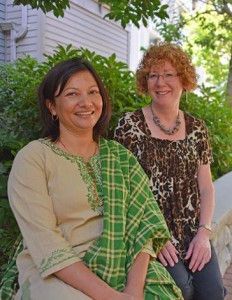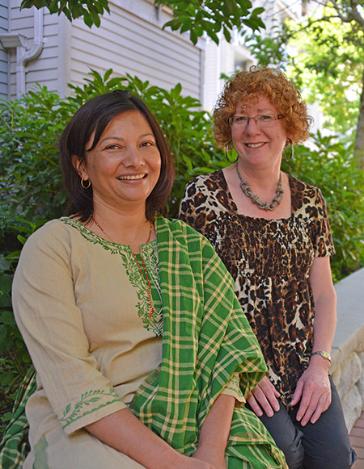By Adrian MacNair, adrian@southdeltaleader.com
It was while Pingala Dhital was lying on the dirty floor of a makeshift tent, using little more than bamboo poles to brace herself in the effort of bringing another child into the world, that she realized she would never go home again.
The woman had spent nearly a decade in refugee camps scattered in Nepal after fleeing her homeland of Bhutan in 1990 with 100,000 other Nepali speakers.
“The country hasn’t admitted there was a civil war,” says Dhital, now 40. “They don’t want to tell anyone.”
Nepalis had been immigrating to Bhutan since as early as 1620, settling mostly on the uninhabited southern border with India. But by the 1980s, Bhutan’s government decided not only to put a stop to the largely illegal immigration of the past three centuries, but also to expel existing Nepali-speaking people.
The Bhutanese Citizenship Act of 1985 was created to preserve the cultural majority of the north with a “One Nation One People” policy requiring all people to wear the national dress, follow an etiquette code, and speak the national language of Dzongkha.
Ethnic Nepalis were soon forced to leave the country or face severe persecution, although Dhital says the government won’t admit it.
“They say they were illegal immigrants and they left,” she says, adding most were actually forced to sign a “voluntary migration forms” stating they had left willingly.
At first, people like her father protested peacefully. But when neighbours began getting arrested they knew it was time to flee.
“I started hearing that soldiers were taking the girls out into the jungle and raping them,” says Dhital, who lived in a village of 600 people.
She escaped across the border into India with her parents and four brothers by pretending they were herding cows.
In August of 1991, the Indian government decided to relocate refugees to Nepal. Her family was rounded up with other Nepalis and taken in a bus to a desolate and windswept camp just across the border.
“I still remember the plastic flapping in the roofs of the huts,” she recalls.
Dhital began crying so loudly that her father’s friend came and hugged her and said he would take her to stay in a house nearby. The 18-year-old didn’t know how to react. Beyond feeling emotions of either happiness or sadness, she could barely bring herself to eat. She was reunited with her family a week later.
“The five days was like five years for me,” says Dhital.
The sickness and famine in the refugee camp took its toll over the next several months as thousands poured over the border.
By the time the United Nations arrived in early 1992 there were 80,000 people and Dhital recalls a funeral being held for 34 people on just one day.
At first the people were happy to eat provisions brought by the U.N. but many died suddenly and unexpectedly. Dhital said when people starve for a long time and then eat quickly the shock to the system can be fatal.
At the peak of the crisis there were 107,000 refugees split among seven refugee camps. During that time she married and had two children in the camps, which made her realize she had to find a new life for her family.
By 2005, after having been displaced for her entire life, Dhital began meeting with Nepali leaders in Kathmandu, backed by the support of Ganga Baral, another woman fighting for a resettlement program.
“On the first day I couldn’t say anything. I just cried,” recalls Dhital.
In 2006, Tsawwassen resident Barb Westlake was reading about the Bhutanese situation online. Having trekked through Asia in 1989-90 she had always harboured a fascination with the Buddhist country.
Feeling like she had to do something to help, Westlake sent an email that somehow found its way to Dhital. After learning more she began a letter writing campaign to the Canadian government to become part of the resettlement program. In 2007 Canada agreed to resettle 5,000 people over five years, and in March agreed to welcome 1,000 more.
“I don’t know if it helped or not but the girls told me it gave them strength,” says Westlake, as Dhital nods next to her.
“We were in a hopeless situation, and here is this lady in a corner of the world in Tsawwassen who is helping us,” says Dhital. “That connected us and gave us hope and courage.”
After meeting with U.N. agencies Dhital began making progress and in 2007 the U.S. government agreed to resettle 60,000 Bhutanese refugees. When Nepali-Bhutanese rebels began making threats on her life, she knew it was time to leave.
Dhital came to the U.S. in February 2008 as the first Bhutanese family under the multinational resettlement program. She landed in Spokane, Wash., but was confused because for the first three days she thought she was in the nation’s capitol.
“I asked where is the White House? And then they brought me a big map and showed me the White House is in this Washington and we were in another one.”
But her family has thrived in the U.S. since, and on May 4, Dhital and her family became official citizens.
Westlake got to see Dhital in Tsawwassen for the first time in an emotional meeting last year, and the two met again recently.
“I don’t know if we ever thought it would happen,” recalls Westlake, laughing. “And then when we met we were friends immediately,”
If Bhutan ever welcomes the Nepalis back to the country, Westlake says she would like to visit with her friend.
“She made a big difference on our life,” said Dhital. “You don’t know how much it means to us.”
Note: The South Delta Leader published this article with headline ‘Cover Story: A new life, a world away’ from where CBS has reproduced. The photo used in the article is by the author himself.

